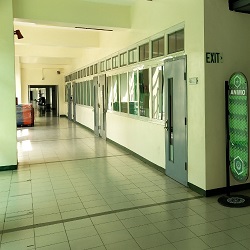









Ensuring accessibility for all individuals using indoor spaces necessitates diligent efforts, especially in high-footfall environments like transportation hubs, arenas, event venues, and retail malls. These locations witness constant heavy pedestrian movement daily, posing unique compliance challenges from intensive wear-and-tear on tactile solutions. As a supplier experienced in navigating such complex accessibility needs, we explore the recommended best practices below for prioritizing code adherence through product selection, inspection protocols, and maintenance routines tailored to high-usage facilities.
Accessibility legislation governing public buildings, like the Accessibility for Ontarians with Disabilities Act (AODA) and Ontario Building Code (OBC), strictly necessitate:
Identifying designated circulation routes demarcated with parallel directional bars or contrast domes.
Installing truncated dome warning tiles alerting hazards like platform edges or stair nosers.
Positioning tactile products flush and as per height/spacing standards for optimum detectability.
Conduct thorough accessibility audits to verify compliance before obtaining occupancy certificates.
Tactiles endure relentless foot strikes daily in bustling spaces. Sustaining visible, durable textures demands judicious proactive efforts to avert accessibility non-compliance penalties. Let’s explore compliant solutions and maintenance tactics optimized for continual high usage.
When outlining infrastructure for crowded locales, durable products proven to withstand extreme utilization include:
Cast Metal Tactiles: Stainless steel plates embedded into new concrete withstand over 10 million footstrikes without fade, lasting facilities’ design lifetimes. Ideally suit subways,concourses.
Porcelain Tactiles: Premium clay composites fired at high-heat cement porcelain’s integrity against scuffs and stains, complementing transit plazas and convention centers aesthetic ambiance for decades.
Composite Polymer Tactiles: Engineered plastics balance durability,affordability making them optimal selections for typical retail,office,hospital settings.Replaceable sections reduce full system replacement costs.
Rubber Tactiles: Flexible elastomers absorb shocks,resist abrasions suiting changing pedestrian flows through heavily used passageways linking concourses smoothly.
While any tactile installed adheres to codes initially,performance varies under exorbitant usage levels. Regular inspections catch degradation early:
Cast/porcelain lasts 10-15+ years with proper adhesive bonding maintenance under heavy impacts.
Polymer composites typically endure 10-15 years before replacement in focused traffic zones experiencing intensive friction.
Rubber remains functional for 7-10 years in the busiest indoor bottlenecks like stairwells/turnstiles.
Partnering with expert tactile solutions, analyzers aid material selection that is aligned to unique building operational needs and budget parameters.
Frequent inspections capture defects early, enabling prompt repairs and maintaining accessibility unhindered:
Inspect high-traffic areas monthly, medium zones quarterly, and low usage biannually.
Note tactile integrity, bond strength, cracks/loosening, and trip hazards requiring urgent remedy.
Check dome height conformity to specifications under a small ruler.
Assess visual clarity from all angles under diverse lighting scenarios.
Consult accessibility advocacy groups annually on user experience feedback.
Engage third-party auditing certification renewals verifying solutions remain standards-compliant.
Address issues promptly as defects are identified without deferring maintenance.
Train cleaning staff on disability product care requirements and notify them of replacements needed.
Accessibility demands regimented protocols sustaining code adherence through:
Deep Cleaning
Schedule quarterly deep scrubs to remove accumulation obscuring textures critical for navigation.
Bonded Integrity
Annually inspect bond lines of applied tactiles probing edges for lifting/degradation needing adhesive repair/replacement.
Wear Resistant Replacement
Proactively swap aging products in busiest zones every 5-7 years, determined through semi-annual inspections catching degradation beforehand.
Documenting Repairs
Note that all completed remedial work with dated photos within maintenance records substantiates diligence toward compliance.
Outsourcing Specialized Tasks
Leverage expert third-party auditing, renewing product certification annually or biannually verifying solutions remain standards-compliant.
The above diligence maintains accessibility triumphs achieved for all users through infrastructure implemented initially according to codes.
While regular inspections/maintenance safeguards accessibility achievements long-term, occasional obstacles necessitate strategic resolution:
Resource Limitations
Prioritize replacement/repairs for the highest usage zones first when budgets constrain the entire facility scope.
Facility Disruptions
Schedule inspections in advance post major events, ensuring tactile solutions aren’t disturbed and require realignment/bond repair.
Damage from Adverse Weather
Inspect immediately after extreme climatic conditions for potential impact, demanding accelerated replacement cycles.
Staffing Issues
Outsource specialized tasks like annual third-party auditing Renewals or conduct temporary tactile training internships for in-house teams.
Addressing compliance hiccups responsively through diligent planning and savvy partnerships reliably maintains accessibility achievements indoors despite unique usage demands encountered.
As the foremost accessibility solutions supplier, our expertise streamlines compliance maintenance for busy indoor facilities:
Advise specifying heavy-duty options matched to traffic intensities and material applications.
Provide maintenance agreements encompassing multi-phase tactile replacement scheduling.
Assist in troubleshooting inspection challenges, offering cost-saving recommendations.
Offer temporary staff training certifying internal teams to conduct basic assessments.
Supplement credentialed third-party auditing renewals, keeping facilities certification current.
Simply put, our guidance supports clients reliably in achieving and sustaining accessibility code adherence indoors, demanding solutions optimized for intensive usage levels. Contact our accessibility advisors today!
A: As the highest usage category, areas handling over 25,000 footfalls or more daily require weekly inspections with monthly deep cleans.
A: Modern rubber blends maintain dimensional integrity regardless of substrates or ambient temperatures indoors. Their shock-absorbing quality aids complex indoor flows.
A: Basic installations can often be addressed in-house with proper training certification. However, annual third-party auditing renewals demand credentialed inspectors.
A: Cast metal embedded tactiles typically leave impressions necessitating leveling filler. Surface applied tiles detach residue-free for seamless accessibility restoration.
Prioritizing accessibility through rigorous facility maintenance matched to traffic intensities safeguards ongoing code adherence and enhances the user experience while shielding management/owners from compliance risks. Tactile Solution Canada assists with customized solutions nationwide.
